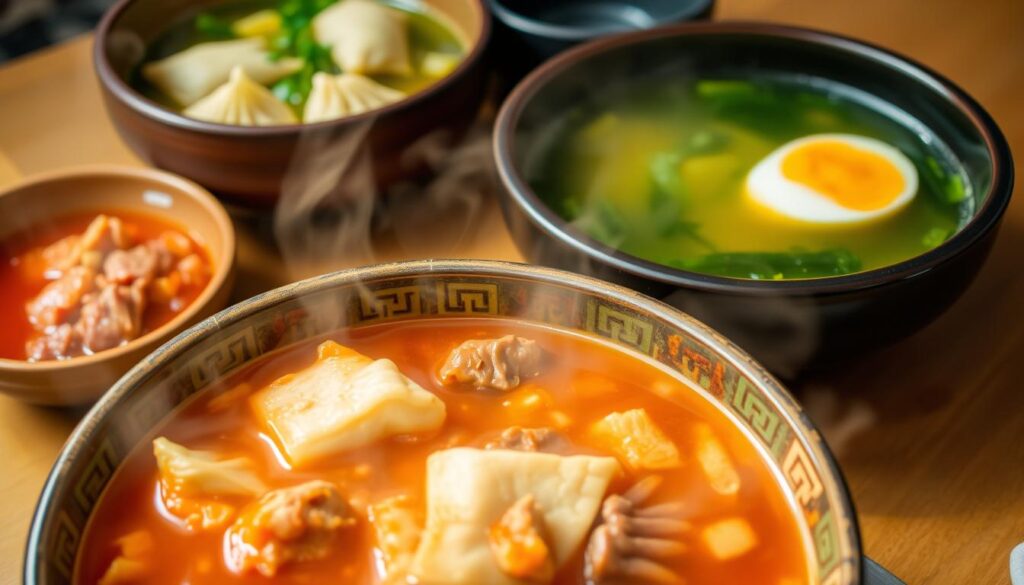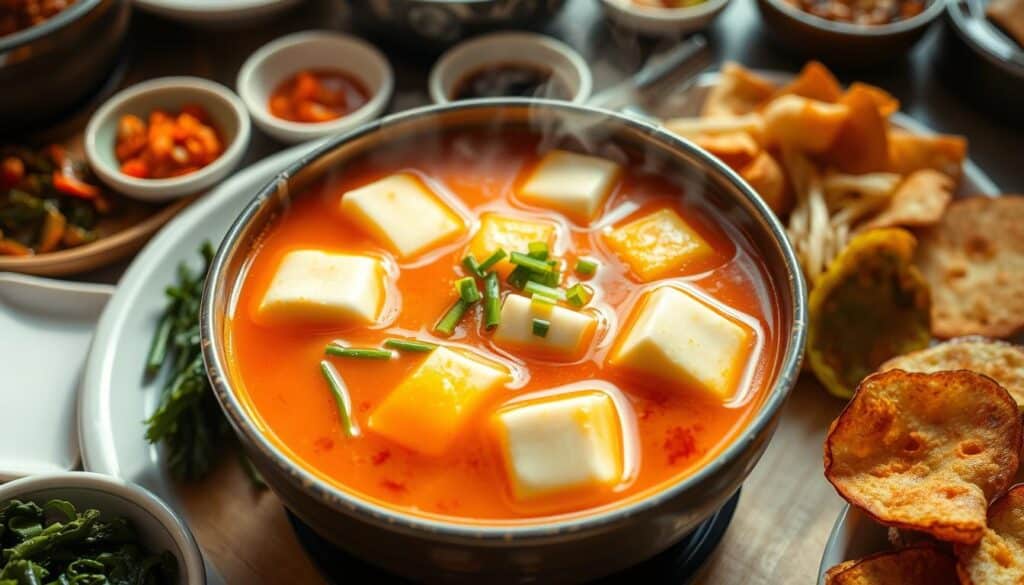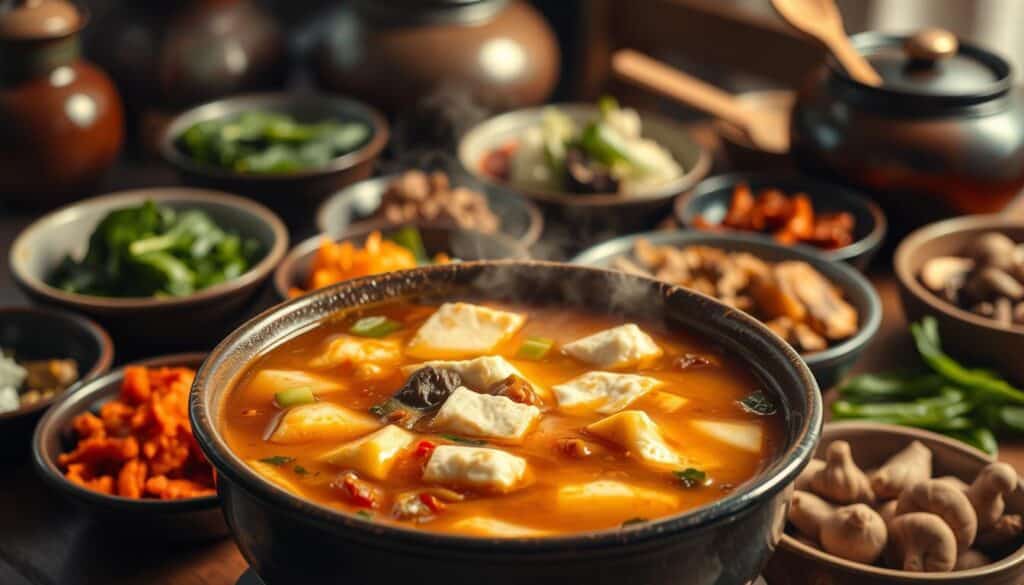There’s something magical about a warm bowl of soup on a cold night. My first time trying Korean soups was at a small restaurant. It was in a busy neighborhood.
The first sip of kimchi jjigae was amazing. The spicy and tangy flavors were like a warm hug. From then on, I loved Korean soup recipes even more.
These soups are not just comfort food. They also have great flavors and health benefits. Ingredients like fermented foods, proteins, and veggies make them special. Let’s explore the world of Korean soups together.

Table of Contents
Kimchi Jjigae (Kimchi Stew)
Kimchi Jjigae is a spicy Korean stew that warms the soul. It’s a comfort food that I love. This stew uses aged kimchi for a rich flavor.
To make it, I use a few key ingredients:
- 1 cup of aged kimchi
- 200 grams of pork belly
- 1 medium onion
- 1 tablespoon of gochugaru (Korean red pepper flakes)
- 4 cups of water
First, I sauté the pork belly until it’s crispy. This adds a nice texture. Then, I add the kimchi and gochugaru to mix the flavors.
After a few minutes, I add water and boil it. Then, I reduce the heat and let it simmer. This makes the pork tender and the flavors rich.
Aged kimchi is key to the stew’s taste. It’s fermented, which is good for health. You can also add tofu or seafood for new flavors.
This stew is fun to make and share. It’s a great dish to enjoy with family and friends.
Samgyetang (Ginseng Chicken Soup)
Samgyetang is a favorite in Korean cooking. It’s a mix of flavors and health perks, perfect for summer. The soup has a chicken stuffed with rice, ginseng, garlic, and jujubes.
To make this soup, I use a 3-4 pound chicken. I clean it well, removing feathers and innards. Then, I mix sticky rice, ginseng, garlic, and jujubes for the stuffing.
After stuffing the chicken, I put it in a pot with water. I let it simmer for an hour. This lets the flavors mix well. People believe it boosts energy, making it a summer favorite.
| Ingredient | Quantity |
|---|---|
| Whole chicken | 1 (3-4 pounds) |
| Ginseng | 4-5 pieces |
| Garlic | 5-6 cloves |
| Sticky rice | 1/2 cup |
| Jujubes (dates) | 3-4 pieces |
| Water | Enough to cover the chicken |
Sundubu Jjigae (Soft Tofu Stew)
Sundubu Jjigae is a soft tofu stew that warms your heart. It’s a Korean spicy stew with creamy uncurdled tofu. My Sundubu Jjigae recipe uses gochugaru for a spicy kick.

- 1 tube of soft tofu
- Seafood (clams or shrimp work beautifully)
- 1 onion, chopped
- 1 tablespoon of gochugaru (Korean chili flakes)
- 1 egg for richness
Start by cooking the onion until it’s soft. Then add seafood to soak up the flavors. When the seafood is done, add gochugaru for spice.
Now, add the soft tofu and simmer. The creamy tofu makes the stew special. Adding an egg at the end adds richness and a nice finish.
This dish is easy to change up. I add different proteins or veggies to make it new. It’s a healthy Korean recipe that’s comforting and nutritious, perfect for any day.
| Ingredient | Quantity | Notes |
|---|---|---|
| Soft Tofu | 1 tube | Use uncurdled for creaminess |
| Seafood | Varies | Clams or shrimp recommended |
| Onion | 1 | Chopped, for aromatic base |
| Gochugaru | 1 tablespoon | Adjust for spice level |
| Egg | 1 | Optional, for creaminess |
Galbitang (Beef Short Rib Soup)
Galbitang is a favorite Korean comfort dish. It’s known for its rich flavor and warmth. The soup has tender beef short ribs as the main ingredient.
To make this tasty Korean beef soup, start by boiling the beef ribs. This makes the meat tender and the broth richer. After boiling for about an hour, remove any froth that forms.
Once the ribs are tender, add sliced daikon radish and chopped green onions. Let them simmer together until the radish softens.
The final seasoning is key to enhancing the flavors. You can adjust the salt and pepper to your liking. Galbitang is often served with steamed rice. This fills the kitchen with comforting aromas and warmth.
Banchan Jjigae (Assorted Side Dish Soup)
Banchan Jjigae is a great way to use up leftover Korean side dishes. It turns them into a tasty Korean soup. I like to mix leftover kimchi, pickled veggies, and tofu for a yummy soup.
By using different banchan, I make a dish that shows off Korean food. It’s fun to try new things and see how they taste together.

Making Banchan Jjigae is easy. Start with a savory broth, like chicken or veggie stock. Then, cut your leftover banchan into small pieces.
If you have kimchi, add it to the broth for a kick. Put the broth and banchan in a pot. Let it simmer for 15 to 20 minutes. This lets all the flavors mix well.
Want to get creative? Add tofu or leftover meats to the soup. This makes the dish your own. It’s a fun way to cook and share meals with family and friends.
Doenjang Jjigae (Soybean Paste Stew)
Doenjang Jjigae is a warm Korean soybean paste stew. It’s full of fermented soybean flavor. It’s made with veggies and proteins, making it very nutritious.
To make a tasty Doenjang Jjigae, start with 2 tablespoons of doenjang and 5 cups of water. Add fresh veggies like zucchini and mushrooms. This stew is simple but full of flavor.
First, mix the water and doenjang in a pot. Let it simmer gently. Then, add your veggies and protein, like tofu. This makes sure everything tastes great.
Stir in the fresh ingredients and watch the kitchen fill with smell. Doenjang Jjigae is not just food. It’s a way to connect with Korean traditions and warm your heart.
Miyeok Guk (Seaweed Soup)
Miyeok Guk is a warm, comforting soup. It’s a traditional Korean dish. New mothers love it for its iron and nutrition.
To make Miyeok Guk, I soak dried Miyeok in water for 30 minutes. Then, I sauté it in sesame oil until it smells good. I add four cups of water and let it simmer.
Miyeok Guk is special because of its taste and health benefits. Seaweed is full of vitamins and minerals. It helps with nourishment and recovery.
